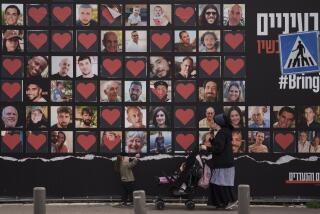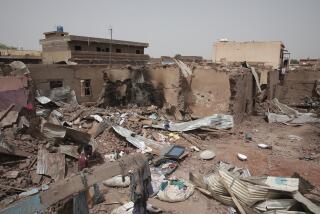Much Tsunami Aid Still Unspent, Report Says
NEW YORK â In the first nine months after the Indian Ocean tsunami, a group of private charities including the American Red Cross and Mercy Corps spent less than half of the $1.8 billion they received from American donors, a new report has found.
A study of several dozen well-known aid organizations by the umbrella group InterAction showed that the consortium spent $743 million through Sept. 30. Many aid groups cited unanticipated problems with coordination and distribution as a reason that they had not spent more since the disaster Dec. 26.
But group leaders also said the transition from immediate life-saving activities to long-term rebuilding programs had necessitated careful spending plans.
âThe recovery effort is one thatâs going to require three to five years at a minimum, and the agencies that are going to stay the course have to extend their funds in a way calculated to allow them to complete the work,â said Jim Bishop, InterActionâs director of humanitarian policy and practice.
The scope of death and destruction also made decision-making difficult, delaying rebuilding, the report said.
âIn several nations, the capacity of the local authorities and civil society to engage in rehabilitation was undercut by high loss of life among civil servants and community leaders, as well as by massive destruction of transport links and vital infrastructure,â it said.
The public outpouring of donations after the giant wave killed more than 200,000 people was unprecedented, raising billions for aid victims from Indonesia to Somalia.
In some countries, individuals collectively gave more than their governments. The immediate reaction -- especially donations in cash -- helped prevent disease and famine, said Jan Egeland, the U.N.âs coordinator for humanitarian relief.
âThe world did exactly the right thing in the tsunami,â Egeland said. âI always feel that this should be our new standard.â
InterActionâs report tracked spending by 62 groups from its 165-member alliance and concluded that on average, they spent 42% of donations received. The report does not cover programs funded by governments or the United Nations.
InterAction spearheaded the assessment to track whether the donations ended up being used for what they were pledged. âAs the response was extraordinary, we had to be accountable to the American people in an extraordinary way,â Bishop said Tuesday.
One of the largest recipients, the American Red Cross, took in $567 million and had one of the lower spending rates, using $167 million, or about 29%.
Spokesman Michael Oko said that was because the organization was carefully building the foundation for long-term programs.
âWe have just finished the first year of a five-year plan,â he said: helping provide clean water, sanitation and shelters.
âThe disaster wiped out everything, including the infrastructure and land title records, adding to the complexities of the issues.â
In contrast, International Medical Corps spent more than 83% of the $24 million it received, because it focused on immediate aid.
âWe are an emergency response organization and our strength is quickly identifying needs and addressing them,â said Nancy Aossey, president of the Los Angeles-based group. âWe are able to quickly connect with a community, and have an impact. They have a stake in their destiny.â
Mercy Corps, which spent $24 million of $44 million, or 55%, has a mix of short- and long-term programs. It will wind up tsunami-related activities in India by the end of the year because the government and local agencies are able to take over aid projects, said Paul Majarowitz, a senior program officer for Southeast Asia.
But in Indonesia, the country that suffered the most deaths, small-loan programs and community-building activities are continuing, he said.
Several agency leaders noted that the response to the tsunami was unusual, and that subsequent disasters have not inspired as much generosity.
A little more than a month after the tsunami struck, the International Federation of Red Cross and Red Crescent Societies, Doctors Without Borders and UNICEF asked donors to divert their gifts intended for tsunami victims to others in need.
Donations for victims of the October earthquake in Pakistan, which killed more than 80,000 people and rendered 3.5 million homeless, have lagged.
âWe still consider that an emergency situation,â said Aossey, the International Medical Corps president.
âWith the tsunami, the emergency passed relatively quickly. But in Pakistan, there are still people facing winter who are dying every day.â
*
(BEGIN TEXT OF INFOBOX)
Relief funds
Aid to tsunami victims from various U.S. groups, according to a report from InterAction, an alliance of U.S.-based international development and humanitarian nongovernmental organizations:
*--* Total private total Organization donations (millions) expenditures (millions)* American Red Cross $567.30 $166.82 AmeriCares $120.00 $22.50 CARE USA $55.00 $7.00 Catholic Relief Svcs $161.83 $25.43 Habitat for Humanity $43.90 $8.56 Intl Intl Medical Corps $23.57 $19.70 Mercy Corps $43.94 $24.15 Oxfam America $30.00 $20.50 Salvation Army World $24.00 $1.56 Svc Ofc Save the Children USA $78.45 $25.49 U.S. Assn. for United Nations High Commissioner for $1.13 $1.13 Refugees U.S. Fund for UNICEF $137.30 $135.40
*--*
*Through Sept. 30
Source: InterAction
More to Read
Sign up for Essential California
The most important California stories and recommendations in your inbox every morning.
You may occasionally receive promotional content from the Los Angeles Times.










